|

by Mark Sircus
August
28, 2018
from
DrSircus Website
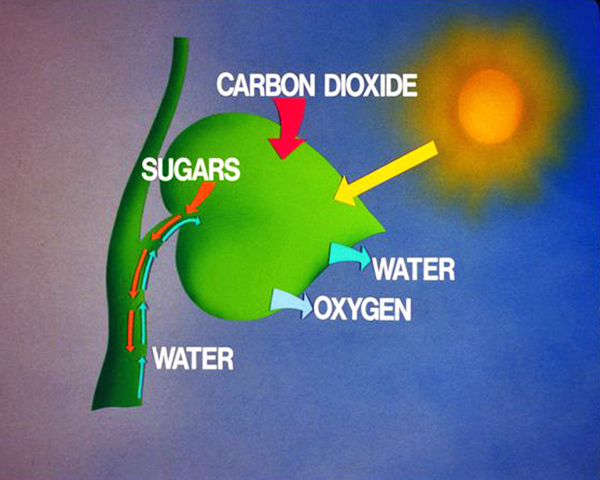
We need to cut
the crap about CO2
and begin to realize that our life and health depend on enough
levels of CO2 in the blood and tissues.
Carbon dioxide is a
nutrient as well as a product of respiration and energy production
in the cells and its lack or deficiency is of itself a starting
point for different disturbances in the body.
Carbon dioxide has many protective functions including increasing
Krebs Cycle activity, which is the
key to health and the greatest way of
avoiding cancer, which happens when
Krebs cycle activity slows down in the mitochondria, so fermentation
has to make up the difference.
Importantly, CO2
also inhibits toxic damage to proteins.
Carbon dioxide is a harmless, colorless, non-toxic, natural gas that
is the key link in the carbon cycle of life. In the presence of a
large amount of carbon dioxide, the hemoglobin molecule changes its
shape slightly in a way that favors the release of oxygen.
Increasing carbon dioxide inhibits lactic acid formation thus helps
control systemic acidification, which decreases oxygen utilization.
CO2 has been found to lead to the better coordination of
oxidation and phosphorylation and increased the phosphorylation
velocity in liver mitochondria.
Any way we put it CO2
is the key to oxygen, to life, to health.
"The end product of
respiration is carbon dioxide, and it is an essential
component of the life process.
The ability to
produce and retain enough carbon dioxide is as important for
longevity as the ability to conserve enough heat to allow
chemical reactions to occur as needed.
Carbon dioxide
protects cells in many ways.
By bonding to amino
groups, it can inhibit the glycation of proteins during
oxidative stress, and it can limit the formation of free
radicals in the blood; inhibition of xanthine oxidase is one
mechanism (Shibata, et al., 1998).
It can reduce
inflammation caused by endotoxin/LPS, by lowering the formation
of tumor necrosis factor, IL-8 and other promoters of
inflammation (Shimotakahara, et al., 2008).
It protects
mitochondria (Lavani, et al., 2007), maintaining (or even
increasing) their ability to respire during stress,"
writes Dr. Ray Peat.
"The suppression of mitochondrial respiration increases the
production of toxic free radicals, and the decreased carbon
dioxide makes the proteins more susceptible to attack by free
radicals.
The presence of
carbon dioxide is an indicator of proper mitochondrial
respiratory functioning. In every type of tissue, it is the
failure to oxidize glucose that produces oxidative stress and
cellular damage," Dr. Peat adds.
Then concludes,
"A focus on
correcting the respiratory defect would be relevant for all
diseases and conditions (including heart disease, diabetes,
dementia) involving inflammation and inappropriate excitation,
not just for cancer.
Carbon dioxide has a
stabilizing effect on cells, preserving stem cells, limiting
stress and preventing loss of function."
Over the
oxygen supply of the body carbon
dioxide spreads its protecting wings.
Friedrich Miescher
Swiss
physiologist, 1885
The German cancer
researcher Dr. Paul Gerhard Seeger [1]
demonstrated in 1938 that in most cases cancer starts in the
cytoplasm, the jelly-like outer part of the cell, and especially in
the energy-producing mitochondria.
Here food fragments are
normally oxidized in a series of enzymatic steps called the
'respiratory chain'.
Seeger showed that in
cancer cells this respiratory chain was more or less blocked,
especially at the site of the important enzyme cytochrome oxidase.
Without it the cell can produce energy only anaerobically like a
fungal cell.
This is very inefficient,
and the resulting overproduction of lactic acid adding even more
acidity to usually an already acidic body.
In 1957 Seeger also
successfully transformed normal cells into cancer cells within a few
days by introducing chemicals that blocked the respiratory chain.
Without enough oxygen, the electron transport chain becomes jammed
with electrons.
Consequently, NAD
[2] cannot be produced, thereby causing glycolysis to produce
lactic acid instead of pyruvate, which is a necessary component of
the Krebs cycle.
In general, we tend to assume that cancer cells are generating
energy using glycolysis rather than mitochondrial oxidative
phosphorylation, and that the mitochondria were dysfunctional.
Advances in research
techniques have shown the mitochondria in cancer cells to be at
least partially functional across a range of tumor types.
However, different tumor
populations have different bioenergetic alterations in order to meet
their high energy requirement meaning the
Warburg effect is not consistent
across all cancer types. [3]
Cancer does not translate
into annihilation of cells mitochondria however it does mean the
cell are fermenting because of compromised oxidization.
CO2
has Antioxidant Properties
Normal arterial levels of CO2 have antioxidant
properties.
Indeed, a group of
Russian microbiologists discovered that,
"CO2 at a
tension close to that observed in the blood (37.0 mm Hg) and
high tensions (60 or 146 mm Hg) is a potent inhibitor of
generation of the active oxygen forms (free radicals) by the
cells and mitochondria of the human and tissues".
(Kogan
et al, 1997).
Dozens of studies have
shown that modern "normal subjects" breathe about 12 L/min at rest,
while the medical norm is only 6 L/min.
As result, blood CO2
levels is less than normal.
As we have seen arterial
hypocapnia (CO2
deficiency) causes tissue
hypoxia that trigger numerous
pathological effects. Cell hypoxia is the main cause of free radical
generation and oxidative stress and CO2 deficiency in the
blood is one of the main causes of hypoxia (low oxygen).
Having a normal level of CO2 in the lungs and arterial
blood (40 mm Hg or about 5.3% at sea level) is imperative for normal
health.
Do modern people have
normal CO2 levels?
When reading the table
below note that levels of CO2 in the lungs are inversely
proportional to minute ventilation rates, in other words, the more
air one breaths the lower the level of alveolar CO2.
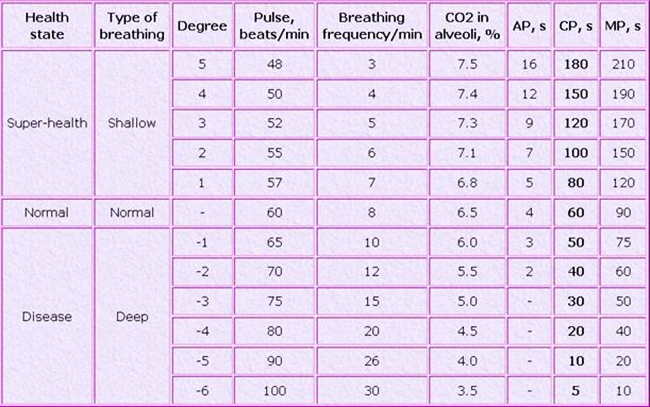
Dr. Lynne Eldridge and many others have noted most modern
adults breathe much faster (about 15-20 breaths per minute) than
what would be considered a healthy respiratory rate.
Respiratory rates in
cancer and other severely ill patients are usually higher, generally
about 20 breaths/min or more. Meaning the general population is
driving down oxygen available to cells opening the door to increased
incidences of cancer.
Heavy metal and chemical
toxification of the cells further impede oxygen with nutritional
deficiencies are the slam dunk that leads to cancer.
Oxygen availability to cells decreases glucose oxidation, whereas
oxygen shortage consumes glucose faster
in an attempt to produce ATP via the less efficient anaerobic
glycolysis to lactate.
This is much of the basis
of oxygen therapy in cancer and a full range of other diseases
because most chronically ill people, if not all, are having a hard
time with both oxygen and its perfectly mated gas, carbon dioxide.
In cancer treatment this
comes with the bonus of stimulating the immune system's cancer
killer cells.
Perfectly
Normal Until its Cancer
We can take some lessons from our muscles when they are worked hard.
When the body has plenty
of oxygen, pyruvate is shuttled to an aerobic pathway to be further
broken down for more energy. But
when oxygen is limited, the body
temporarily converts pyruvate into a substance called lactate, which
allows glucose breakdown - and thus energy production - to continue.
Even in healthy athletic
individuals, when we put the muscles to great challenges oxygen
levels fall temporarily showing us what happens in cells when they
are oxygen starved.
In cancer the change becomes permanent. Cancer cells will continue
with fermentation of glucose and the production of lactate even in
the presence of oxygen though some evidence that some cancer cells,
especially young cancer cells can be reverted back to normal cells
if they can be provided enough oxygen and enough opportunity to
detoxify.
Lactic acid in our tissues is a cause of biological problems for
many reasons principle among them is the fact that lactic acid
displaces carbon dioxide. The main features of stress metabolism
include increases of stress hormones, lactate, ammonia, free fatty
acids, and fat synthesis, and a decrease in carbon dioxide.
Lactic acid in the blood
can be taken as a sign of defective respiration, since the breakdown
of glucose to lactic acid increases to make up for deficient
oxidative energy production.
Glucose can be metabolized into pyruvic acid, which, in the presence
of oxygen, can be metabolized into carbon dioxide. Without oxygen,
pyruvic acid can be converted into lactic acid. The decrease of
carbon dioxide generally accompanies increased lactic acid
production.
The ability of lactic acid to displace carbon dioxide is probably
involved in its effects on the blood clotting system.
It contributes to
disseminated intravascular coagulation and consumption coagulopathy,
and increases the tendency of red cells to aggregate, forming "blood
sludge," and makes red cells more rigid, increasing the viscosity of
blood and impairing circulation in the small vessels. (Schmid-Schönbein,
1981; Kobayashi, et al., 2001; Martin, et al., 2002; Yamazaki, et
al., 2006.)
Lactate and inflammation promote each other in a vicious cycle (Kawauchi,
et al., 2008).
Low
thyroid leads to low production of
carbon dioxide and wastage of glucose.
Dr. Ray
Peat
Carbon dioxide protects cells in many ways.
By bonding to amino
groups, it can inhibit the glycation of proteins during
oxidative stress, and it can limit the formation of free
radicals in the blood; inhibition of xanthine oxidase is one
mechanism.
(Shibata, et al., 1998).
It can reduce
inflammation caused by endotoxin/LPS, by lowering the formation
of tumor necrosis factor, IL-8 and other promoters of
inflammation.
(Shimotakahara, et al., 2008)
It protects
mitochondria (Lavani, et al., 2007), maintaining (or even
increasing) their ability to respire during stress.
Carbon dioxide has a
stabilizing effect on cells, preserving stem cells, limiting stress
and preventing loss of function.
Carbon dioxide can be
used to prevent adhesions during abdominal surgery, and to protect
the lungs during mechanical ventilation. Enough carbon dioxide is
important in preventing an exaggerated and maladaptive stress
response.
A deficiency of carbon
dioxide (such as can be produced by hyperventilation, or by the
presence of lactic acid in the blood) decreases cellular energy (as
ATP and creatine phosphate) and interferes with the synthesis of
proteins (including antibodies) and other cellular materials.
Bicarbonate to
the Rescue
For hundreds or even thousands of years, the therapeutic value of
carbonated mineral springs has been known.
Baking soda is the wonderful
medicine it is because it gives us instant access to more CO2
without exercise and without slowing down our breathing.
Either stomach acid or
lemon added to bicarbonate turns baking soda instantly into carbon
dioxide.
References
[1] The only book
available in English is Seeger, P.G. and S. Wolz: Successful
biological control of cancer by combat against the causes.
Neuwieder Verlagsgesellschaft, Neuwied, Germany 1990. The most
important book is Seeger, P.G: Krebs - Problem ohne Ausweg?
("Cancer - Problem without Solution?") Verl. f. Medizin Fischer,
Heidelberg, Germany 1974, 2nd ed 1988
[2] Nicotinamide adenine dinucleotide, abbreviated
NAD+, is acoenzyme found in all
living cells. The compound is a dinucleotide, since it consists
of two nucleotides joined through their phosphate groups. One
nucleotide contains an adenine base and the other nicotinamide
In metabolism, NAD+ is involved in redox reactions, carrying
electrons from one reaction to another. The coenzyme is,
therefore, found in two forms in cells: NAD+ is an oxidizing
agent - it accepts electrons from other molecules and becomes
reduced. This reaction forms NADH, which can then be used as a
reducing agent to donate electrons.
[3] Biochem Soc Trans. 2016 Oct 15; 44(5): 1499–1505.
The Warburg effect: 80 years on.
The Evidence Proves that...
CO² is Not a Greenhouse Gas
by Dr. Tim
Ball
September
13, 2018
from
Technocracy Website
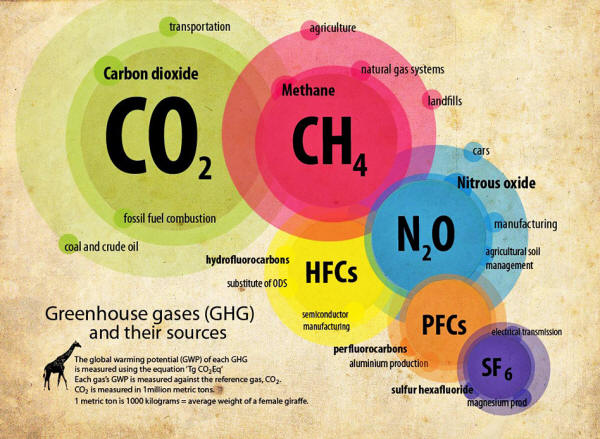
The CO²
error is the root of the biggest scam in the history
of the world, and has already bilked nations and
citizens out of trillions of dollars, while greatly
enriching the perpetrators.
In the end, their goal is global Technocracy (aka
Sustainable Development), which grabs and sequesters
all the resources of the world into a collective
trust to be managed by them.
The Intergovernmental Panel on Climate Change (IPCC)
claim of human-caused
global warming (AGW) is built
on the assumption that an increase in atmospheric CO2
causes an increase in global temperature.
The IPCC claim is what
science calls a theory, a hypothesis, or in simple English, a
speculation...
Every theory is based on
a set of assumptions. The standard scientific method is to challenge
the theory by trying to disprove it. Karl Popper wrote about
this approach in a 1963 article,
Science as Falsification.
Douglas Yates
said,
"No scientific theory
achieves public acceptance until it has been thoroughly
discredited."
Thomas Huxley made
a similar observation.
"The improver of
natural knowledge absolutely refuses to acknowledge authority,
as such. For him, skepticism is the highest of duties; blind
faith the one unpardonable sin."
In other words, all
scientists must be skeptics, which makes a mockery out of the charge
that those who questioned AGW, were global warming 'skeptics'.
Michael Shermer
provides a likely explanation for the effectiveness of the charge.
"Scientists are
skeptics. It's unfortunate that the word 'skeptic' has taken on
other connotations in the culture involving nihilism and
cynicism. Really, in its pure and original meaning, it's just
thoughtful inquiry."
The scientific method was
not used with the AGW theory.
In fact, the exact
opposite occurred, they tried to prove the theory. It is a treadmill
guaranteed to make you misread, misrepresent, misuse and selectively
choose data and evidence. This is precisely what the IPCC did and
continued to do.
A theory is used to produce results. The results are not wrong, they
are only as right as the assumptions on which they are based.
For example, Einstein
used his theory of relativity to produce the most famous formula in
the world; e = mc2.
You cannot prove it wrong
mathematically because it is the end product of the assumptions he
made. To test it and disprove it, you challenge one or all of the
assumptions.
One of these is
represented by the letter "c" in the formula, which assumes nothing
can travel faster than the speed of light. Scientists challenging
the theory are looking for something moving faster than the speed of
light.
The most important assumption behind the AGW theory is that an
increase in global atmospheric CO2 will cause an increase
in the average annual global temperature. The problem is that in
every record of temperature and CO2, the temperature
changes first.
Think about what I am
saying. The basic assumption on which the entire theory that human
activity is causing global warming or climate change is wrong.
The questions are, how
did the false assumption develop and persist?
The answer is the IPCC needed the assumption as the basis for their
claim that humans were causing catastrophic global warming for a
political agenda.
They did what all
academics do and found a person who gave historical precedence to
their theory. In this case, it was the work of Svante Arrhenius.
The problem is he didn't say what they claim.
Anthony Watts'
2009 article identified many of the
difficulties with relying on Arrhenius.
The
Friends of Science added
confirmation when they translated a more obscure 1906 Arrhenius
work.
They wrote,
Much discussion took
place over the following years between colleagues, with one of
the main points being the similar effect of water vapor in the
atmosphere which was part of the total figure.
Some rejected any
effect of CO2 at all.
There was no
effective way to determine this split precisely, but in 1906
Arrhenius amended his view of how increased carbon dioxide would
affect climate.
The issue of Arrhenius
mistaking a water vapor effect for a CO2 effect is not
new. What is new is that the growing level of empirical evidence
that the warming effect of CO2, known as climate
sensitivity, is zero.
This means Arrhenius
colleagues who "rejected any effect of CO2 at all" are
correct. In short, CO2 is not a greenhouse gas.
The IPCC through the definition of climate change given them by the
United Nations Framework Convention on Climate Change (UNFCCC)
were able to predetermine their results:
a change of climate
which is attributed directly or indirectly to human activity
that alters the composition of the global atmosphere and which
is in addition to natural climate variability observed over
considerable time periods.
This allowed them to only
examine human-causes, thus eliminating almost all other variables of
climate and climate change. You cannot identify the human portion if
you don't know or understand natural, that is without human, climate
or climate change.
IPCC acknowledged this in
2007 as people started to ask questions about the narrowness of
their work. They offered the one that many people thought they were
using and should have been using.
Deceptively, it only
appeared as
a footnote in the 2007 Summary
for Policymakers (SPM), so it was aimed at the politicians.
It said,
"Climate change in
IPCC usage refers to any change in climate over time, whether
due to natural variability or as a result of human activity.
This usage differs
from that in the United Nations Framework Convention on Climate
Change, where climate change refers to a change of climate that
is attributed directly or indirectly to human activity that
alters the composition of the global atmosphere and that is in
addition to natural climate variability observed over comparable
time periods."
Few at the time
challenged the IPCC assumption that an increase in CO2
caused an increase in global temperature. The IPCC claimed it was
true because when they increased CO2 in their computer
models, the result was a temperature increase.
Of course, because the
computer was programmed for that to happen.
These computer models are
the only place in the world where a CO2 increase precedes
and causes a temperature change. This probably explains why their
predictions are always wrong.
An example of how the definition allowed the IPCC to focus on CO2
is to consider the major greenhouse gases by name and
percentage of the total.
They are water vapour (H20)
95%, carbon dioxide (CO2) 4%, and methane (CH4)
0.036%.
The IPCC was able to
overlook water vapor (95%) by admitting humans produce some, but the
amount is insignificant relative to the total atmospheric volume of
water vapour.
The human portion of the
CO2 in the atmosphere is approximately 3.4% of the total
CO2 (Figure 1) To put that in perspective, approximately
a 2% variation in water vapour completely overwhelms the human
portion of CO2.
This is entirely possible
because water vapour is the most variable gas in the atmosphere,
from region to region and over time.
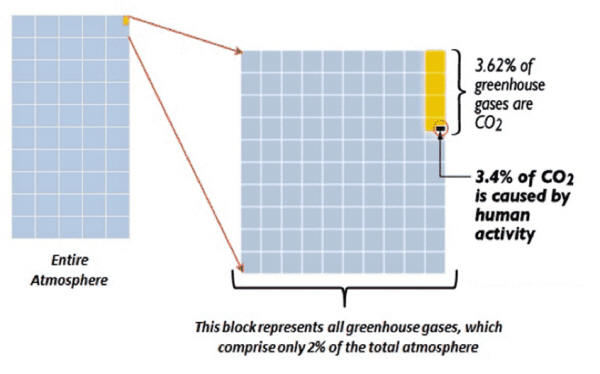
Figure 1
In 1999, after two IPCC Reports were produced in 1990 and 1995
assuming a CO2 increase caused a temperature increase,
the first significant
long term Antarctic ice core record
appeared.
Petit, Raynaud, and
Lorius were presented as the best representation of levels of
temperature, CO2, and deuterium over 420,000-years.
It appeared the
temperature and CO2 were rising and falling in concert,
so the IPCC and others assumed this proved that CO2 was
causing temperature variation. I recall Lorius warning against
rushing to judgment and saying there was no indication of such a
connection.
Euan Mearns
noted in his robust assessment that
the authors believed that temperature increase preceded CO2
increase.
In their seminal
paper on the Vostok Ice Core, Petit et al (1999) [1]
note that CO2 lags temperature during the onset of
glaciations by several thousand years but offer no explanation.
They also observe
that CH4 and CO2 are not perfectly aligned
with each other but offer no explanation.
The significance of
these observations are therefore ignored. At the onset of
glaciations temperature drops to glacial values before CO2
begins to fall suggesting that CO2 has little
influence on temperature modulation at these times.
Lorius reconfirmed his
position in a
2007 article:
"our [East
Antarctica, Dome C] ice core shows no indication that greenhouse
gases have played a key role in such a coupling [with radiative
forcing]"
Despite this, those
promoting the IPCC claims ignored the empirical evidence.
They managed to ignore
the facts and have done so to this day.
Joanne Nova
explains part of the reason they
were able to fool the majority in her article,
"The 800 year lag in
CO2 after temperature - graphed." when she wrote
confirming the Lorius concern.
"It's impossible to see a lag of centuries on a graph that
covers half a million years, so I have regraphed the data from
the original sources…"
Nova concluded after
expanding and more closely examining the data that,
The bottom line is
that rising temperatures cause carbon levels to rise. Carbon may
still influence temperatures, but these ice cores are neutral on
that. If both factors caused each other to rise significantly,
positive feedback would become exponential.
We'd see a runaway
greenhouse effect. It hasn't happened. Some other factor is more
important than carbon dioxide, or carbon's role is minor.
Al Gore knew the ice core data
showed temperature changing first.
In his propaganda movie,
An Inconvenient Truth he separated
the graph of temperature and CO2 enough to make a
comparison of the two graphs more difficult.
He then distracted with
Hollywood histrionics by
riding up on a forklift to the
distorted 20th century reading.
Thomas Huxley said,
"The great tragedy of
science - the slaying of a lovely hypothesis by an ugly fact."
The most recent ugly fact
was that after 1998 CO2 levels continued to increase but
global temperatures stopped increasing.
Other ugly facts included
the return of cold, snowy winters creating a PR problem by 2004.
Cartoons appeared (Figure 2.)
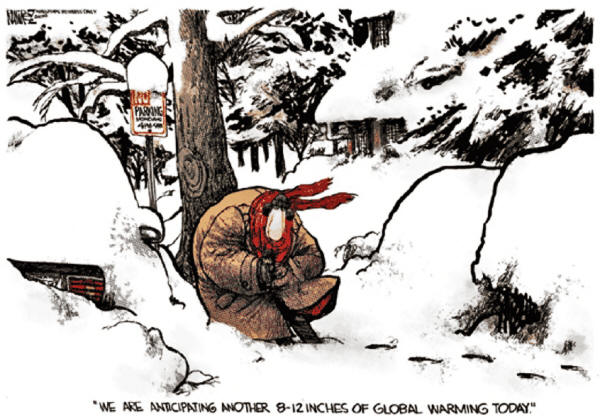
Figure 2
The people controlling the AGW deception were aware of what was
happening. Emails from 2004 leaked from the University of East
Anglia revealed the concern.
Nick at the Minns/Tyndall
Centre that handled publicity for the climate story said,
"In my experience,
global warming freezing is already a bit of a public relations
problem with the media."
Swedish climate expert on
the IPCC Bo Kjellen replied,
"I agree with Nick
that climate change might be a better labelling than global
warming."
The disconnect between
atmospheric CO2 levels and global temperatures continued
after 1998.
The level of deliberate
blindness of what became known as the "pause" or the hiatus became
ridiculous (Figure 3).
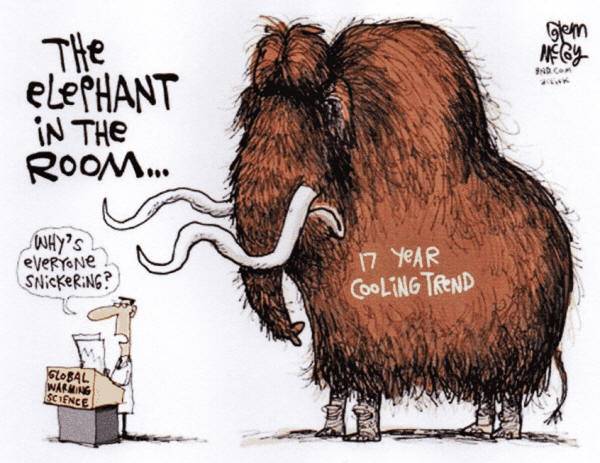
Figure 3
The assumption that an increase in CO2 causes an increase
in temperature was incorrectly claimed in the original science by
Arrhenius.
He mistakenly attributed
the warming caused by water vapor (H2O) to CO2.
All the evidence since confirms the error. This means CO2
is not a greenhouse gas. There is a greenhouse effect, and it is due
to the water vapor.
The entire claim that CO
and especially human CO2 is absolutely wrong, yet these
so-called scientists convinced the world to waste trillions on
reducing CO2.
If you want to talk about
collusion, consider the cartoon in Figure 4.
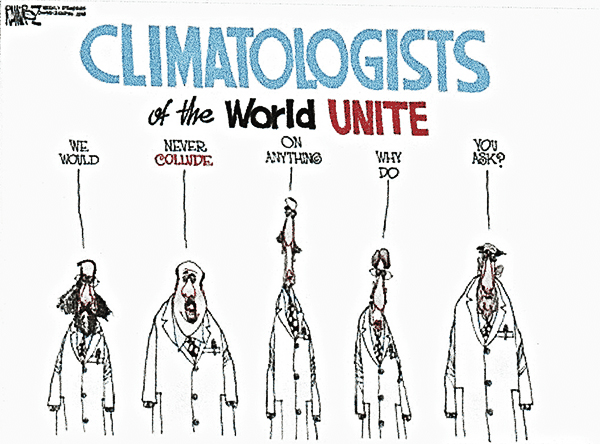
Figure 4
| 







